In the shadows of Portugal’s well-known coastal beauty and historic urban charm is a world that often escapes the typical traveler’s eye. Beyond the sunny beaches and the busy cityscapes, a different Portugal emerges – one that blinks at the adventurous souls willing to discover the unknown. Embarking on a journey along National Road 2 (N2), a winding route that unfolds throughout the heart of the nation, offers a unique opportunity to explore this hidden side of Portugal.
National Road 2, commonly referred to as N2, is more than just a road – it is a path of discovery. Extending across 738,5 kilometers (459 miles), N2 makes its way through unique villages and towns, and beautiful mountains and rivers, unveiling an authentic Portugal that often escapes the eyes of most travelers.
The road itself evolved from very old paths that were established two thousand years ago by the Roman Empire. It is like a patchwork blanket that was built, little by little, over almost 2 centuries. Far removed from the noisy and busy highways, N2 presents a chance to embrace the unknown, savoring the subtleties that make Portugal a true hidden treasure.
This road, sometimes called Portugal’s Route 66, flows from North to South, through the heartland, offering a glimpse of the unspoiled beauty and the lives within it. While Lisbon’s and Porto’s well-known magnificence is undoubtedly captivating, the country’s true essence lies in its less traveled and known locations, and N2 can definitely serve as a gateway to this hidden side.
Throughout this article, we will take an expedition along National Road 2, from North to South, stopping at selected spots that collectively create a captivating puzzle of experiences. From the timeless charm of traditional architecture to the fairytale-like landscapes, each stretch of kilometers along N2 grants a peek into another side of the soul of the nation.
Below, as if it were an itinerary, we will suggest to the reader where to go, what to see, where to stay, where to eat and, when relevant, where to drink. Each one of the 11 districts that this road crosses is a world on its own, and we hope our selection enables you to embark on a journey where the essence of Portugal’s concealed interior radiates to life.
District 1 – Vila Real – Kilometers 0 to 99
As N2 starts its way through Portugal, it unveils an intriguing duality. The first of the 11 districts, Vila Real, is home to two distinct, yet harmonious, Portuguese landscapes. To the north, from Chaves to Vila Pouca de Aguiar, in a region called Trás-os-Montes, Vila Real shows its rugged, rocky character, with a landscape that has been shaped by time and tradition.
A bit further south, from Vila Real to Santa Marta de Penaguião and Peso da Régua, you will find yourself in the mesmerizing Douro Valley, a land where the art of winemaking takes the stage.
Vila Real’s unique position at the crossroads of these contrasting terrains, which exists due to the differences in the soil (granite to the north and schist for the valley), makes it a remarkable stop along N2. It offers travelers the chance to explore the raw beauty of the north and the refined tastes of the valley in a single journey.
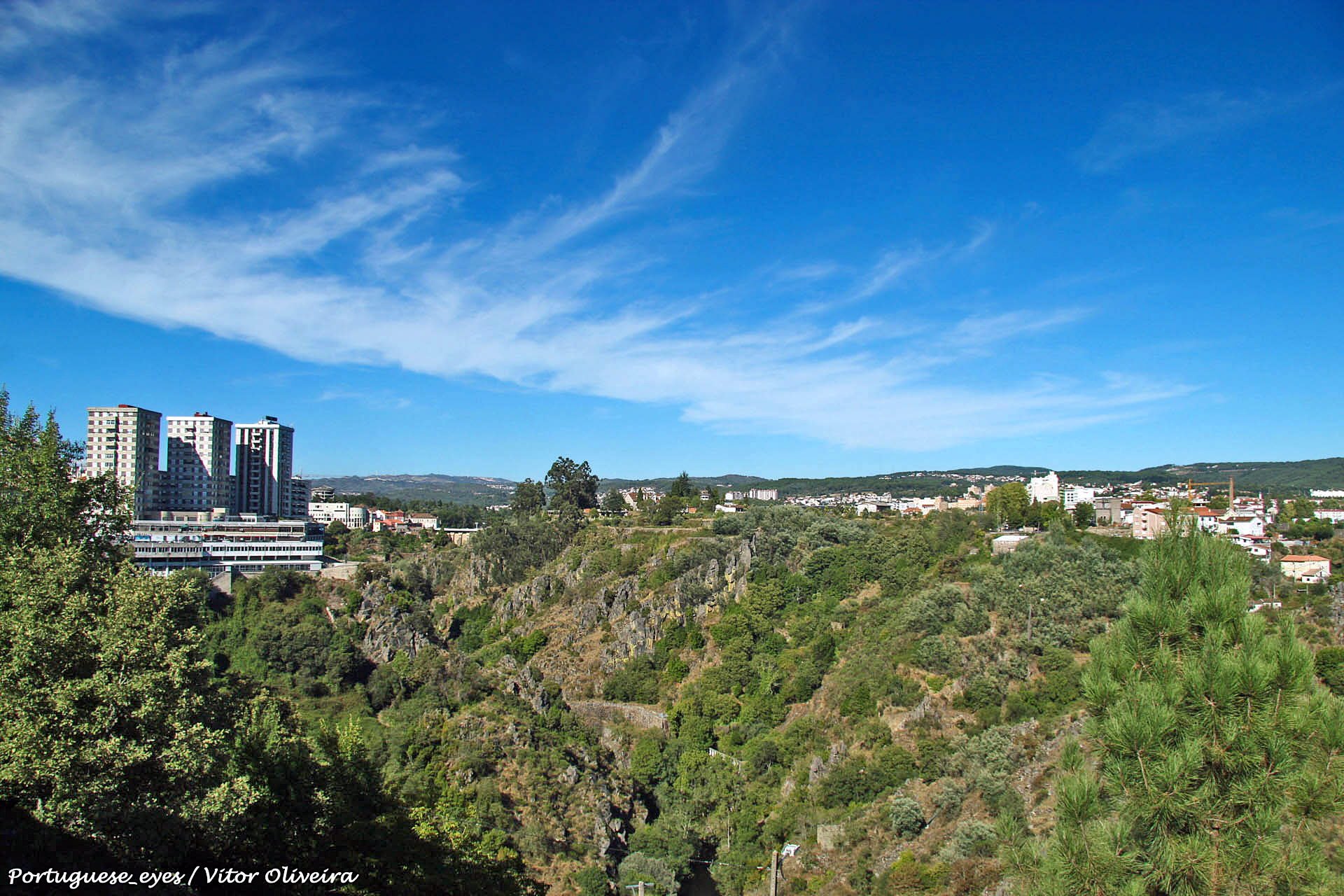
Where to go?
Chaves (Km 3): This place, where National Road 2 begins, possesses a history dating back to the Roman Empire. Its thermal waters are a highlight, offering the perfect opportunity for relaxation and rejuvenation. Walk through the town’s ancient streets and bridges, and make sure you do not miss the medieval castle that distinguishes the skyline.
Vila Pouca de Aguiar (Km 30): This is a very peaceful town surrounded by natural beauty. Explore the beautiful landscapes of Alvão Natural Park and try on the town’s famous firewater, made from local grapes. It is a serene escape for those seeking tranquility.
Vila Real (Km 56): This city, which gives the district its name, offers a harmonious mixture of historic charm and modern vitality. The Mateus Palace is an architectural gem, while the scenic natural landscapes of the Alvão Natural Park and the Douro Valley are within a small distance. It is the ideal place for establishing a base to explore the district.
Santa Marta de Penaguião (Km 74): This town is situated within the Douro Valley, and its beautiful terraced vineyards are considered a UNESCO World Heritage site. Sample wines, explore the terraces, and take in the amazing panoramic views. Perfect for both wine enthusiasts and nature lovers.
Peso da Régua (Km 84): Peso da Régua, which is known as the capital of Port wine, is a key destination for wine connoisseurs. Situated alongside the Douro River, the town offers breathtaking riverfront views, and the opportunity to explore the wine cellars and taste the wine that made the region famous.
What to see?
Old lands, like these, certainly have plenty to observe and admire. From the architectural patrimony to the breathtaking landscapes, there is unimaginable beauty hidden all over.
- Castelo de Chaves (Chaves Castle): the best view of the city and its surroundings;
- Museu da Região Flaviense (Museum of the Flaviense Region): home to historical artefacts of the Roman Empire that once existed there;
- Termas de Chaves (Chaves’ Thermal Waters): next to the Tâmega River, these waters sprout at 73ºC, and are recommended for treating musculoskeletal conditions, the digestive and respiratory systems, and for relieving stress, tiredness, and anxiety;
- Barrela’s Menhir/Statue: attributed to the end of the bronze age, or to the first iron age, this monument remains in situ, right by the roman road that connected Merida (Spain) to Chaves (Portugal);
- Trajano’s Roman Bridge: a 2000 year old bridge, from the times of the Roman Empire, which remains magnificent. Today, this bridge with 150 km and 12 visible arches can only be crossed by foot, and is definitely worth the visit;
- Chaves Balconies: it is impossible not to notice the vibrant balconies along Rua Direita and Praça do Município. The delicate and detailed wooden balconies certainly have an origin and a story, however, there is not one reference about it;
- Mateus Palace: it is one of the best examples of the baroque architectural style in Vila Real. Apart from the architectural interest, its exterior forms a museum-like space filled with valuable and diverse works of art (furniture, decoration, documents, and books);
- Panóias Sanctuary: the oldest rock sanctuary of the Iberian peninsula (from century II or III). It is one of the only sanctuaries in the world that has its story carved on the rocks;
Where to stay?
- Forte de São Francisco Hotel (Chaves);
- Palace de Vidago (Chaves);
- Hotel Aquae Flaviae (Chaves);
- Hotel Casino de Chaves (Chaves);
- Hotel Aguiar da Pena (Vila Pouca de Aguiar);
- Pensão Areias (Vila Real);
- Casa Agrícola da Levada (Vila Real);
- Hotel Régua Douro (Peso da Régua);
- Wine Hotel da Quinta do Vallado (Peso da Régua).
Where to eat?
- Adega Faustino: an old wine warehouse that was transformed into a restaurant (Chaves);
- Aprígio: a family owned tavern that became a restaurant. Family cuisine. (Chaves);
- A Talha: a type of culinary that blends popular and traditional dishes with high quality products. (Chaves);
- Cozinha do Convento: the restaurant of Forte de São Francisco Hotel. Creative cuisine with snacks. (Chaves);
- Cais da Vila: a very old railway warehouse that was transformed into a restaurant. The culinary embodies the two different realities present within the district, and is the result of the Chef’s vast experience with Michelin Starred restaurants. (Vila Real);
- Pastelaria Gomes: established almost 100 years ago, it is the city’s hotspot. Known for its products, and for the traditional and regional recipes. (Vila Real);
- Castas e Pratos: a fine dining restaurant established within an old railway warehouse. It is known for its culinary and wine selection. The vibe is rustic, but very elegant. (Peso da Régua).
Where to drink?
- Palmeirim D’Inglaterra (Chaves);
- Head Rock (Vila Pouca de Aguiar);
- Adega Cooperativa de Vila Real (Vila Real);
- Lavradores de Feitoria (Vila Real);
- Caves Santa Marta (Santa Marta de Penaguião);
- Quinta dos Avidagos (Santa Marta de Penaguião);
- H.O – Horta Osório Wines (Santa Marta de Penaguião);
- Quinta Vale Dornas (Peso da Régua);
- Quinta Santa Júlia (Peso da Régua);
- Quinta Seara d’Ordens (Peso da Régua);
- Quinta do Zimbro (Peso da Régua).
District 2 – Viseu – Kilometers 102 to 230
As National Road 2 continues its course, the district of Viseu appears. Situated within the charming interior, Viseu blends history, culture, and natural richness. This district, with roots tracing back to the times of the Roman Empire, allows a unique glimpse into Portugal’s past while embracing the spirit of the present.
Viseu´s beautiful countryside and charming towns are perfect for those searching for a truly authentic Portuguese experience, where old traditions and contemporary innovations coexist in harmony. As part of the N2 route, this district invites exploration, promising historical and cultural wonders, and the genuine warmth of its inhabitants.
Far away from the busy highways, N2 provides a chance to discover the multifaceted character of this district. Within its historical landmarks and culinary delicacies, you will definitely find places to delight yourself and relax along the way.
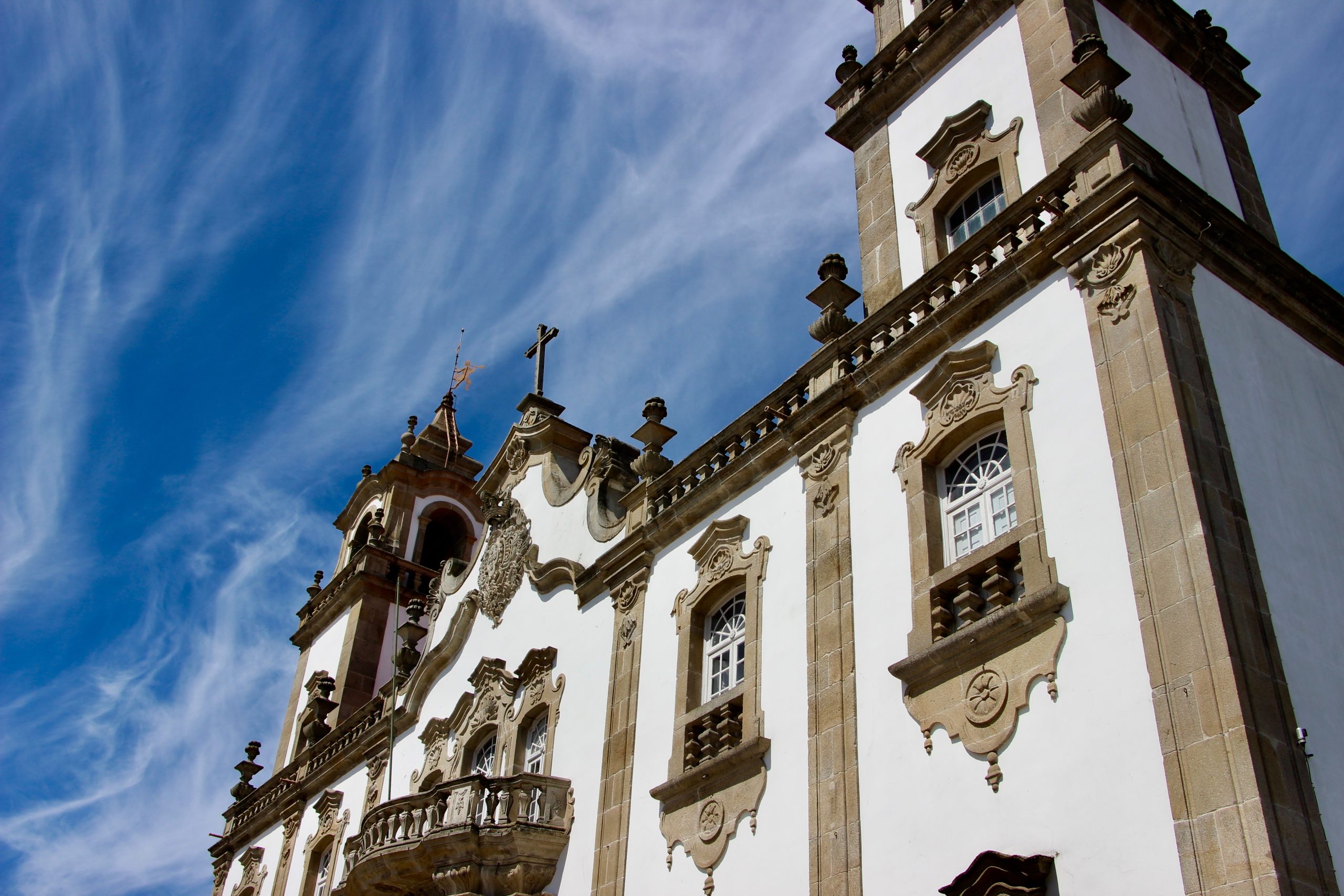
Where to go?
Lamego (Km 102): This is a city steeped in history, which is known for the impressive Sanctuary of Nossa Senhora dos Remédios. The baroque staircase leading to the sanctuary offers mesmerizing views of the city and the surrounding vineyards, making it a must go-to place for those that delight themselves with architectural splendor and scenic beauty.
Castro D’Aire (Km 120): This town is a hidden gem of district nº2. It is a charming place situated within the stunning Lafões Mountains. Perfect for nature enthusiasts looking for landscapes to admire and trails to hike.
São Pedro do Sul (Km 134): A town renowned for its shooting hot springs and spa resorts. It provides a tranquil nature escape with the bonus of its therapeutic mineral waters. Perfect for relaxation.
Viseu (Km 159): The district’s namesake is a vibrant cultural hub with a rich historical core. It is a city where tradition and innovation coexist perfectly, which is known for its Roman architecture and delightful museums.
Tondela (Km 205): Situated in the Dão-Lafões region, this town is another amazing spot for wine lovers. It is a great place to explore the vineyards, savor the excellent and specific Dão wines, and experience the district’s winemaking culture.
Santa Comba Dão (Km 220): Offers one of the best glimpses into Portugal’s rural charm. Next to the Dão River, the town is a place to connect with the beauty of the countryside and explore its historical heritage.
What to see?
- Lamego Museum: an old episcopal palace that was transformed into a museum.
- Grão Vasco National Museum: a former bishop’s palace that was transformed into a painting museum.
- Caramulo Museum: belongs to the Abel Lacerda Foundation. Originally built in 1921, it used to be the largest sanatorium of the Iberian Peninsula.
- Chapel of São Pedro de Balsemão: the building is, at least, 1 thousand years old. It was built, over the years, on top of an old Roman village.
Where to stay?
- Six Senses Douro Valley (Lamego);
- Casa de Cambres (Lamego);
- Hotel Lamego (Lamego);
- Hotel São Paulo (Lamego);
- Aldeia do Codeçal (Between Lamego and Castro D’Aire)
- Hotel de Montemuro (Castro D’Aire);
- Hotel Severino José (Tondela).
Where to eat?
- Vindouro (Lamego);
- Adega Matos (Lamego);
- Taskazita (Lamego);
- Restaurante da Associação Etnográfica e Social de Montemuro: a restaurant well known for its high quality regional food and built-in artisan store. (Castro D’Aire);
- Quinta da Magarenha: a big and beautiful place known for its quality products and the hospitality of its workers. (Viseu);
- Muralha da Sé: located at the top of the historical square, this traditional and cozy restaurant serves traditional food. (Viseu);
- Santa Luzia (Viseu);
- Casa Arouquesa: known for its exceptional meat and wine selection. (Viseu);
- Três Pipos: it is probably the best restaurant within this district. It is known for its quality, menu design, and wine selection. (Tondela).
Where to drink?
- Quinta da Pacheca (Lamego);
- Quinta da Casa Amarela (Lamego);
- Caves da Murganheira (Tarouca, 15 km away from Lamego);
- Presunteca de Lamego (Lamego);
- Quinta dos Grilos (Tondela);
- Caves Vinícolas Martinho Alves (Tondela);
- Casa de Mouraz. biological wine. (Tondela).
District 3 – Coimbra – Kilometers 231 to 304
Continuing along National Road 2, we arrive at the Coimbra District. The path along N2 is mainly through the woods, and does not cross the city of Coimbra. However, ancient wisdom and cherished traditions echo all over. Right in the heart of the country, Coimbra is a mix of academic brilliance, cultural legacies, and natural wonders.
With a history stretching back to the ages, this district is a window into Portugal’s intellectual heritage and living traditions. Its landscapes and historic towns, together with the above mentioned, make it another top spot for those looking for a genuine Portuguese experience. It is a place where the pursuit of knowledge and the embrace of local traditions exist as one.
Coimbra District, a hot stop along N2, provides travelers with an opportunity to explore the many facets of this region, from its commended institutions to its local culinary, and places to find tranquility and rejuvenation along the journey.
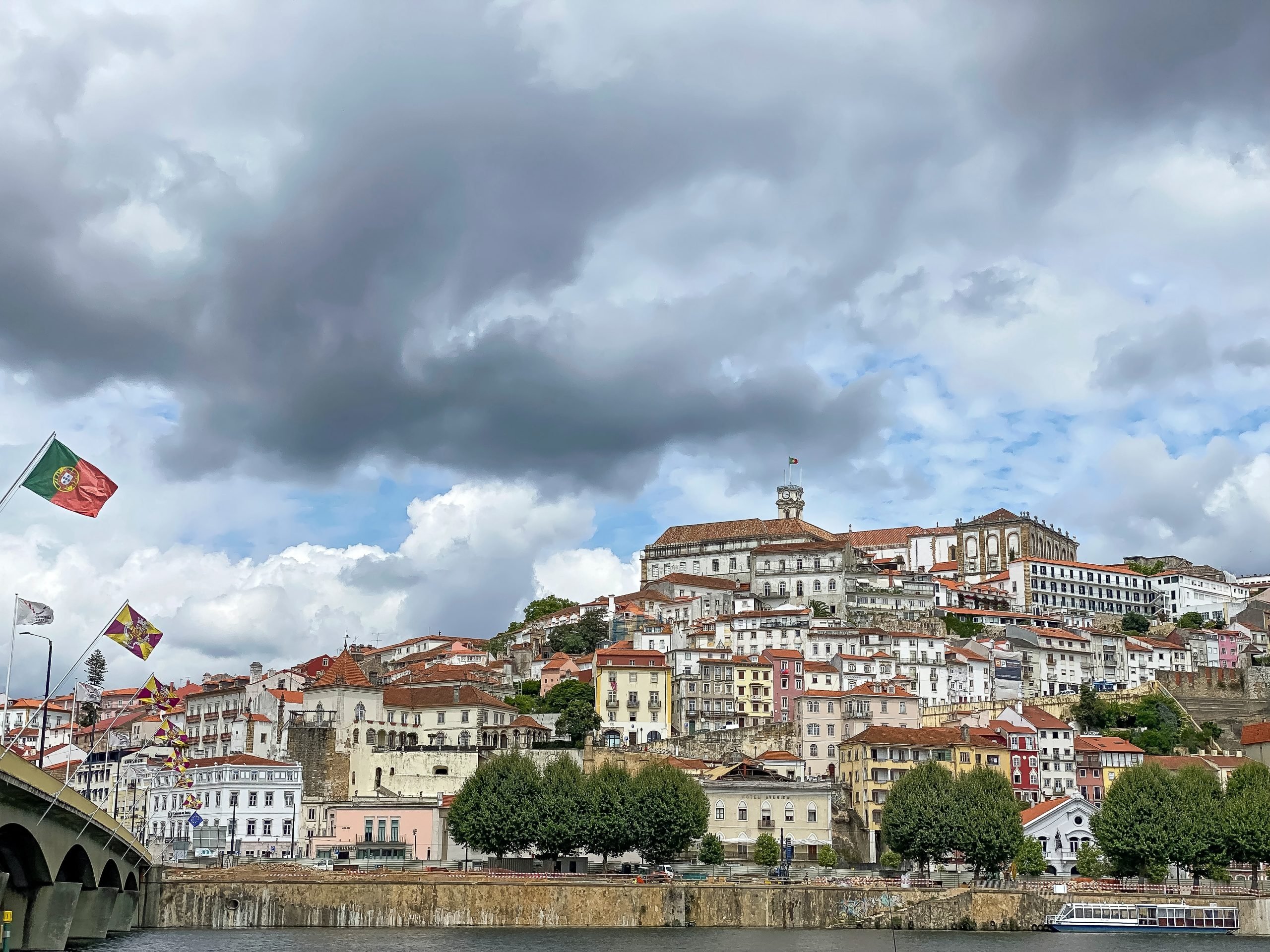
Where to go?
Penacova (Km 235): This is a charming town located along the Mondego River. It is known for its natural environment and the Santa Maria da Serra viewpoint that gives panoramic views of the river and the surrounding landscape. N2 travelers can explore nature and the high quality water sources, engage in outdoor activities like hiking and river sports, and find immense tranquility within this rural setting.
Coimbra (22 Km from Penacova, through N110): Detouring to this city, despite its distance from National Road 2 , is totally worth it. It will be a complete cultural immersion. Within its historic center, with the University of Coimbra, the UNESCO-listed library, the restaurants, the music, and the people, the city’s rich heritage and ambiance make the trip worthwhile for N2 travelers.
Vila Nova de Poiares (Km 246): This is a town where you can observe the implications of large scale poor urban planning. Although, it is completely surrounded by green hills and forest. For this reason, while not very pretty in terms of architecture, it is a place where you can truly experience the beauty of nature, walking outdoors or engaging in any other exterior activities. The town is also known for its traditional Portuguese cuisine.
Lousã (Km 261): Lousã is a charming region situated in the Lousã Mountain range. It is known for the Lousã Castle, an historical site that offers mesmerizing views of the region. For nature lovers, the Lousã Mountains provide excellent hiking trails, particularly in the schist villages. These villages are very beautiful places where travelers can see and explore unique traditional buildings and agglomerations made from local schist stone.
Góis (Km 270): Some claim this town was founded even before Portugal’s existence as an independent country, by the father of our first King. It is situated on the banks of the Ceira River. Its historical architecture is definitely worth a look. However, this town became a hub for outdoor activities and adventure. Travelers can kayak or swim in the river’s transparent waters. It is also known for its Motorbike Festival, which attracts bikers and enthusiasts from around the world. Perfect for those seeking a mix of adventure and cultural experiences.
What to see?
- Monastery of Lorvão: this national monument is the crown jewel of this district. In the 12th century it worked as an important monastery and center for the production of illuminated writings. Today, it is home to many treasuries, and is definitely worth a visit. (Penacova);
- Viewpoints of Penacova: there are several beautiful viewpoints where travelers can admire the region and its surroundings. Breathtaking views are guaranteed. (Penacova);
- Reconquilho River Beach: it is one of the country’s most famous river beaches. Located on the left bank of the Mondego River, this beautiful beach is easily accessible, and offers mesmerizing panoramic views. (Penacova);
- Chapel of Mártir S. Sebastião: this chapel, which dates back to the 18th century, is located at the entrance of the royal bridge. It is an example of beautiful historical architecture. (Góis);
- Fountain of Pombal: what exists today dates back to the 19th century and was built on top of an older fountain. The legend says that if a man and a woman gaze at each other while there, they will be forever in love. (Góis).
Where to stay?
- Residencial D. Elvira (Vila Nova de Poiares);
- Hotel Casa nas Serras (Vila Nova de Poiares);
- Palácio da Lousã Boutique Hotel (Lousã);
- Casa da Fonte (Góis);
- Quintinha Carvalhal (Góis);
- Casa da Terra (Góis).
Where to eat?
- A Grelha: award winning restaurant known for its quality traditional food. (Vila Nova de Poiares);
- O Burgo: another award winning restaurant known for its high quality regional food. Located near the natural pools. (Lousã);
- Casa Velha: open since 1986, this comfortable restaurant serves traditional food and its design allows customers to observe the kitchen through a big glass window. (Lousã);
- Licor de Beirão GastroBar: the gastro pub of one of the most famous Portuguese mainstream liquors. (Lousã);
- Restaurante Alvaro’s: no one would go there for the way it looks (just another café), but everyone should go there by the way they cook. Very well known for the work of its chef. (Góis);
- Café Central (Góis).
Where to drink?
- Licor de Beirão Gastrobar (Lousã);
- Quinta de Foz de Arouce (Lousã).
District 4 – Leiria – Kilometers 304 to 325
Although N2’s path through the Leiria District may be brief, it has a distinctive charm that is worth a stop. This district is like a microcosm of Portugal’s diverse offerings, from its pristine coastline along the Silver Coast to the green and abundant Leiria Pine Forest, and to its cultural scenery and historic sites.
The journey along National Road 2, through this district, only crosses the pine forest. This woodland is a vast mystical place with an enchanting atmosphere. It was planted in the 13th century for strategic and economic reasons connected to agriculture and as a source of timber for construction and naval purposes. Rich in history, this district is ideal for nature lovers, providing many opportunities for hiking, picnicking, and embracing the serenity of a natural beauty that is essentially Portuguese.
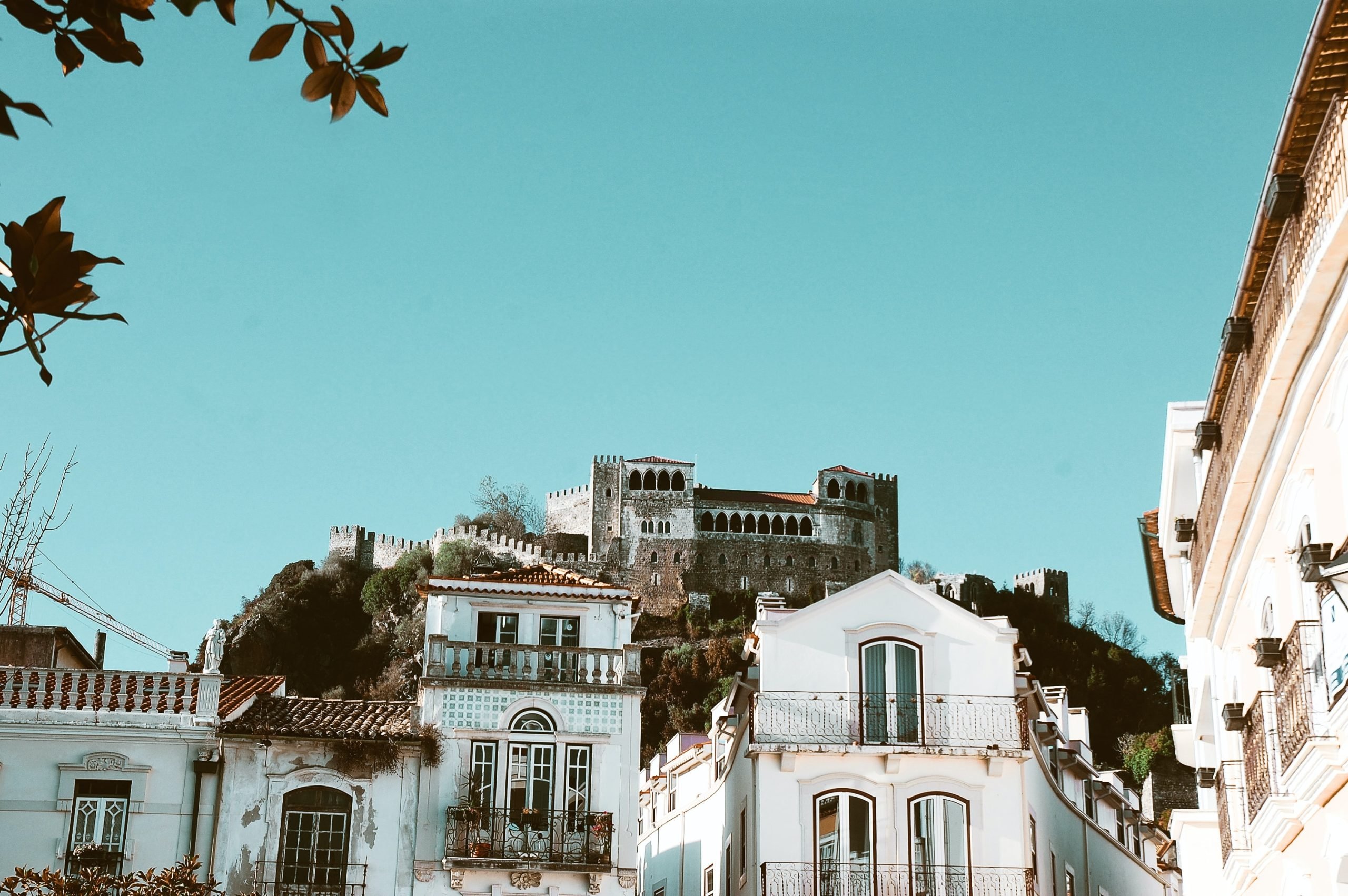
Where to go?
Pedrógão Grande (Km 309): located on the northern right corner of the district, this region astonishes with its serene natural beauty. It is the only town that N2 crosses along this district, and is a haven for outdoor enthusiasts because of its hiking trails, lakes, river beaches, and forest. Whether you’re seeking a peaceful escape by the water, or an immersive experience through the forest, this may very well be the perfect spot for you.
What to see?
- Pedrógão Grande’s Center for Touristic Interpretation: this center is divided in several thematic spaces that mirror the touristic offer of the region. It uses diverse imagery and audio technology to provide precise and helpful information to travelers;
- Igreja da Misericórdia: this temple, built in 1470, is a very good example of a quality restoring;
- House Museum Comendador Manuel Nunes Corrêa: an old family house that was donated by the owners to Pedrógão. Has paintings, personal objects, and musical instruments, among other things;
- Mosteiro River Beach: a beautiful river beach with a restaurant/bar built on top of an old olive oil mill;
- Igreja Matriz de Pedrógão Grande: this national monument was built, over the years, thanks to the work of several famous architecture and artistic names;
- Ponte Filipina do Cabril: this old bridge was built between 1608 and 1610. Has 3 beautiful arches, and is entirely made of granite blocks;
- Freemasonry Museum: this rare museum is located within Turismo Rural Villa Isaura.
Where to stay?
- Turismo Rural Villa Isaura: a regional farmhouse that was transformed into a small rural hotel. Serves breakfast composed of traditional and regional homemade desserts and pastries;
- Residencial Turiscabril: a small hotel-like venue installed within an old building right in the center of Pedrógão. Has 16 rooms and a restaurant.
Where to eat?
- Sabores do Pinhal: along N2 in Sertã, after Pedrógão Grande. A typical portuguese restaurante. Good quality food and great servisse. Known for its fish soup, typical regional dishes, and deserts.
- Restaurante Pensão O Cobra: along N2 in Vila de Rei, after Sertã. The place is more than 80 years old, and the current owners have had it for more than half of that time. The decoration is low-key, but the food is amazing. The wine selection matches the standards. A typical Portuguese restaurant focused on regional cuisine. The pension part has 4 rooms with bathroom, TV, and phone.
- Restaurante Ponte Velha: along N2 in Sertã. Has a big panoramic room with a nice view. Known for its quality regional cuisine, and dishes like fish soup and a special lamb. The wine selection is great, the price/quality relationship is good, and the service is attentive and effective.
- Restaurante Ponte Romana, “O Delfim”: along N2 in Sertã. Pleasant venue located near the river. Opened in 1985, and is known for its high quality, rich and authentic regional cuisine.
Where to drink?
- Pub & Bar Da Carvalha: In Sertã. known for its quality late night snacks and drinks.
- Bar o 29: In Sertã. Also known for its late-night quality food and drinks, and for its peculiar vibe.
- Bar de Facto: In Sertã. Like Bar o 29 it has quality food and drinks, but with its own vibe.
District 5 – Castelo Branco – Kilometers 326 to 375
Right in the heart of Portugal, Castelo Branco is a lesser-explored district that provides an authentic and uncommon experience. Rich in history, this district is home to historic villages like Monsanto, known as the “most Portuguese village in Portugal”, a place where houses made of stone mix perfectly with giant boulders, and Serra da Estrela, Portugal’s highest mountain range.
However, like in district 4, N2 only crosses a tiny bit of this region. In this case, the lower left corner. Despite its extension, it is the perfect place for travelers looking for a quieter, and more genuine side of Portugal. From the beautiful landscapes to the hiking trails, traditional artisanry, and the local cuisine, this portion of N2 promises to be a rewarding destination to explore.
Where to go?
Sertã (Km 329): Located along the banks of the Nêspera River, this town is an amazing spot. Its picturesque atmosphere offers a delightful blend of history and nature, with its medieval streets, bridges, and green surroundings. Even though it has an incredibly aged population, Sertã is the perfect destination for those seeking tranquility, offering riverfront strolls, regional cuisine, and a range of outdoor activities like hiking and/or water sports.
Vila de Rei (Km 364): This town is a jewel within the district, and is characterized by its landscapes and the opportunity it provides for outdoor adventures. Located alongside the Zêzere River, Vila de Rei has beautiful river beaches that are perfect for swimming and relaxing. It is also a hiker’s paradise, with its vast extension of trails that lead to viewpoints hidden in the middle of pine-covered hills. Ideal for nature lovers and adventurers.
What to see?
- Santo Amaro Chapel: a small, and historical rural temple from the 6th century. (Sertã);
- Ribeira Grande River Beach: this pristine beach is located right in the heart of Sertã. It is like a frontier that separates the old and the new part of the town. Has all of the necessary support infrastructure. (Sertã);
- Boneca Fountain: built in 1858, with a different name, was the village’s sole water source for a long time. Today, it was transformed into a proper leisure area. (Sertã);
- Old Bridge: this architectural wonder from the 17th century was used by the inhabitants of the town as a defense point during the French invasions. It is a 64m bridge with 6 round arches. (Sertã);
- Chapel of Nossa Senhora dos Remédios: the observable remainings allow to infer that it was built on top of an old Templar monastery. On the 15th of august, every year, thousands of pilgrims visit it. (Sertã);
- Municipal Museum of Vila de Rei: the perfect place to understand how people used to live in the region. It allows to understand their day-to-day, the activities, their habits, etc. (Vila de Rei).
Where to stay?
- Convento da Sertã Hotel (Sertã);
- Hotel da Montanha (Sertã);
- Hotel Lar Verde (Sertã);
- Vila Maior (Sertã);
- A Velha Casa (Vila de Rei).
Where to eat?
- Santo Amaro Restaurant: a typical Portuguese restaurant. Quality traditional and regional food. (Sertã);
- Ponte Velha Restaurant: similar to Santo Amaro because of the common management. Apart from the quality traditional and regional cuisine, and the wine selection, it is known for its effective and considerate service. (Sertã);
- Ponte Romana Restaurant: this traditional restaurant offers views of the river and the old bridge. Can get very busy. Serves quality large portions. (Sertã);
- Pensão Restaurante O Cobra: located on a very calm street, this restaurant has been working for 70 years. Known for its quality food and wine selection. (Vila de Rei).
District 6 – Santarém – Kilometers 376 to 425
Continuing south along National Road 2, after the district of Castelo Branco, we enter the Santarém District. Once again, N2 only crosses the upper right corner of this district, and does not pass through the city of Santarém itself. However, even though the city is worth visiting, this district offers a number of attractions beyond the city itself. Travelers can enjoy the countryside, historic villages, and the beauty of the Ribatejo region.
Moreover, the district is known for its fertile farmland, for the Lusitano horse breed, and traditional bull festivals. Additionally, the district’s wineries and vineyards are a great way to experience another facet of Portuguese viticulture. Santarém’s rich rural heritage, together with its cultural and culinary traditions, make it a top spot for those looking for an authentic taste of Portugal’s interior.
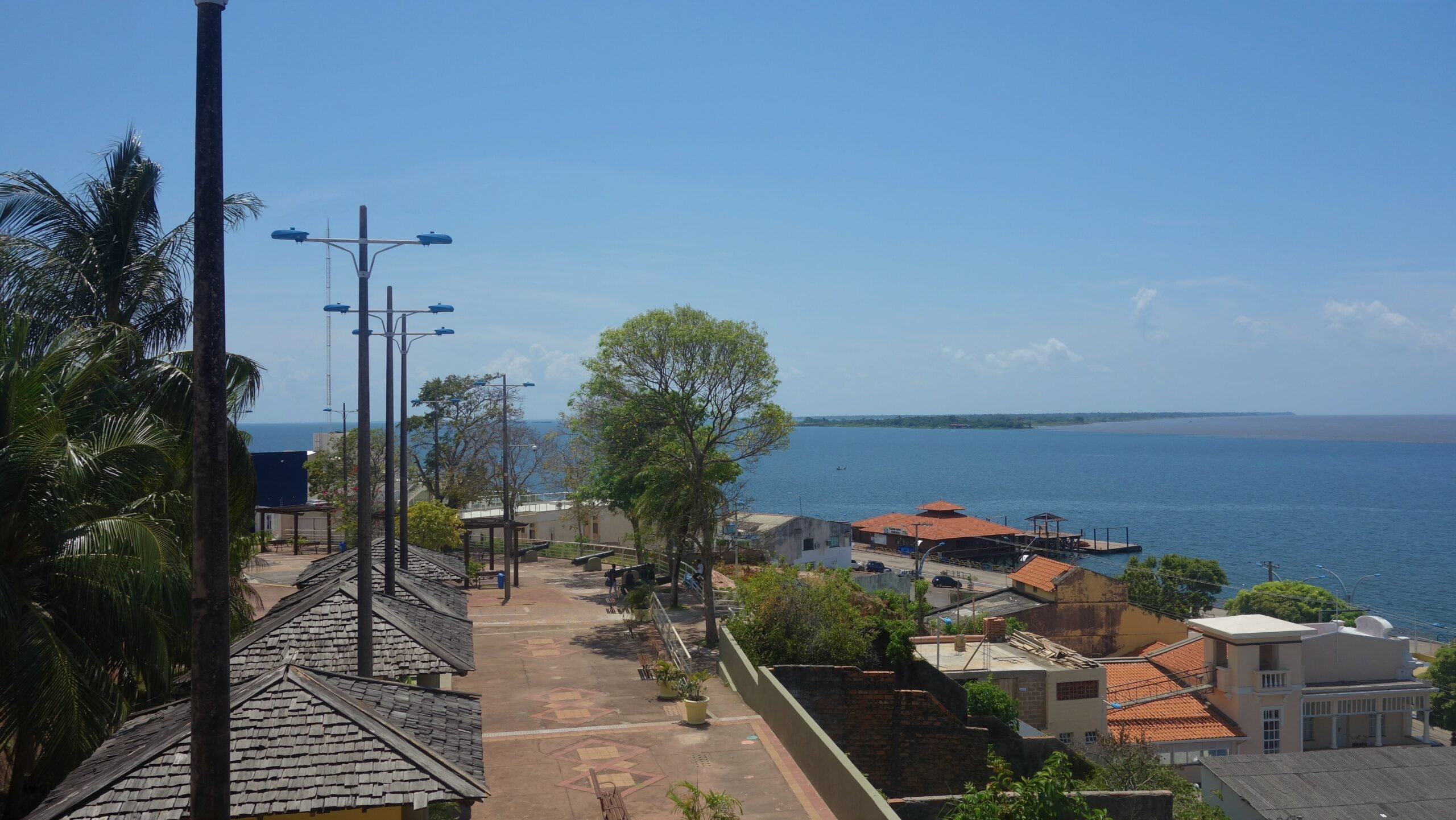
Where to go?
Sardoal (Km 376): This small town is all about rustic charm. Its historical center with the cobbled streets, centuries-old buildings, and tranquil atmosphere make it a spot worth seeing. Like all the other places mentioned throughout the article, although for slightly different reasons, Sardoal offers a taste of authentic Portuguese life. It is a place where you can savor local cuisine, explore the medieval heritage, and learn the unhurried pace of rural living.
Abrantes (Km 420): with its prime location along the Tejo River, Abrantes is a captivating destination. Rich in history, the town is known for its beautiful Castle (Castelo de Abrantes) situated high on the hill and offering panoramic views of its surroundings. This town is an ideal place for history enthusiasts and those looking for a scenic escape. Travelers can also enjoy the riverside promenade where they can walk, relax, dine, and admire the river view. Moreover, because of the frequent cultural events, Abrantes is also a hub for music, arts, and local festivities.
What to see?
- Igreja Matriz do Sardoal: a big old church from the end of the 14th century. (Sardoal);
- Church of Misericórdia: a church from the end of the 16th century. (Sardoal);
- The Indian Ash trees: these trees, planted around the stairs of the Convent of Santa Maria da Caridade, are classified and protected. With more than 500 years, they were brought by Vasco da Gama from its second trip to India. (Sardoal);
- D. Maria Cork Oak (Sobreiro): this classified and protected tree is more than 200 years old. (Sardoal);
- Old Fountain (Fonte Velha): the oldest fountain in Sardoal. According to the legend, there were two hidden boxes in the water. One would lead to heaven, other to hell. (Sardoal);
- Castle of Abrantes: built in 130 BC. This national monument is the main attraction of the region. The fortress is made up of the Governor’s Palace, the Church of Santa Maria do Castelo, the Keep, and the East, and South entrances. Its garden is one of the most photogenic sites in Abrantes. (Abrantes);
- Saint Vincent’s Church: a national monument promoted by King D. Sebastião and designed by a military architect. It was built on top of the remains of an old church destroyed by the Moors. (Abrantes).
Where to stay?
- Segredos de Vale Manso (Abrantes);
- Quinta de Coalhos (Abrantes);
- Lirius (Abrantes);
- Vera Cruz (Abrantes).
Where to eat?
- Restaurante Santa Isabel: this traditional restaurant blends the culinary of the three surrounding regions (Ribatejo, Alentejo, Beira). Quality food and reasonable wine selection. (Abrantes);
- Tasquinha Daldeia: a restaurant that mixes traditional and modern culinary. (Abrantes);
- As Três Naus: an old restaurant that serves traditional and regional food. (Sardoal);
- Quatro Talhas: a little restaurant with a cozy atmosphere that serves traditional food. Known for the excellent service. (Sardoal).
Where to drink?
- Quinta do Côro (Sardoal);
- Quinta Vale do Armo (Sardoal);
- Quinta do Casal da Coelheira – Centro Agrícola do Tramagal (Abrantes);
- Monte Olivete Sociedade Agrícola Unipessoal Lda. (Abrantes).
District 7 – Portalegre – Kilometers 426 to 467
Entering this district means entering another region of Portugal. When traveling through National Road 2, entering the Portalegre District means entering the well-known region of Alentejo. It is a convincing destination for N2 travelers because of its picturesque landscapes, charming towns, and preserved culture.
Portalegre is a gateway to Alentejo’s beautiful plains, massive olive groves, and vineyards. It is also the perfect place for travelers to indulge in the typical regional cuisine and try the local wines. The path through N2 is somewhat short. However, it is beautiful. Making most of the way along the right bank of a massive dam, the journey along this part of National Road 2 guarantees scenic landscapes, and a lot of fresh air.
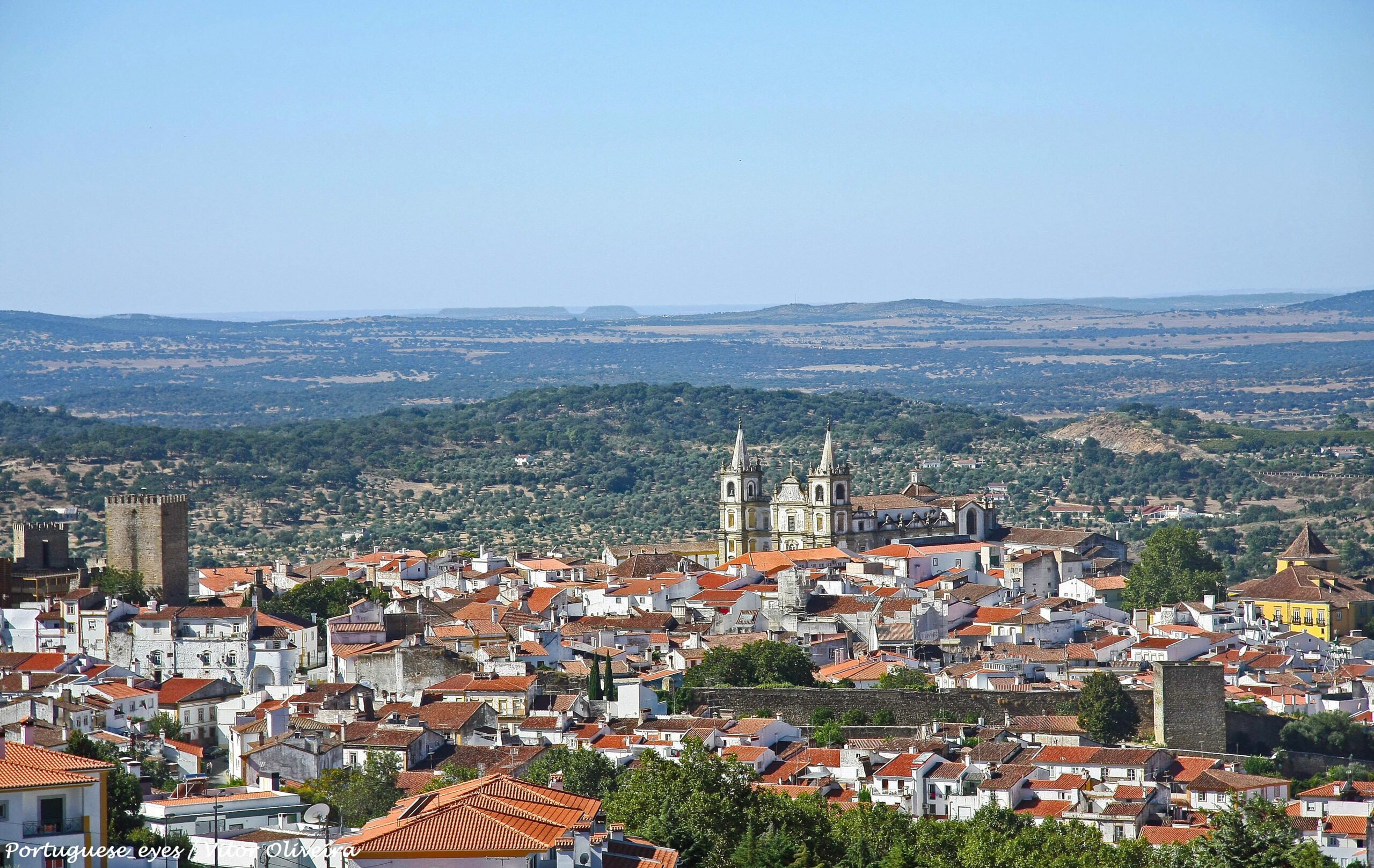
Where to go?
Ponte de Sor (Km 430): this delightful city is a pleasant, beautiful, and very well arranged place. Over the years, it became an important road intersection. For that reason, it gained a new life. In fact, it was one of the first Portuguese towns to have an electric lighting system, whilst most other towns used gas. Situated near the Montargil Dam, this beautiful city is also a paradise for water enthusiasts. Travelers can partake in water activities like kayaking and water skiing, while enjoying the tranquil beauty of the region.
Avis (Km 468): this town gave the name to one of Portugal’s royal dynasties. It is an historic town with a beautiful medieval castle. Just like Ponte de Sor, it is perfect for those that love water activities. It is near the Maranhão Dam, and it provides a wide range of opportunities for practicing water activities, going to the river beach, and enjoying the beauty and tranquility of the scenery.
What to see?
- Ponte de Sor’s riverside area: right by the river, it is perfect for walking around, cycling, kayaking, diving, or playing tennis. (Ponte de Sor);
- Igreja Matriz de Ponte de Sor: built from 1887 to 1903, this gothic revival architecture work is a beautiful monument. (Ponte de Sor);
- Center for Arts and Culture: established in a very old cereal and rice factory, this building is home to the municipal library, art galleries, and the Contemporary Culture Formation Center. There is also a theater and a resident company. (Ponte de Sor);
- Pedestrian Bridge: an innovative and unique engineering and architectural work. At night, the lighting interacts with pedestrians that walk along the tubular structure, changing colors. (Ponte de Sor);
- Montargil Reservoir (Albufeira): beautiful for its landscape and its surroundings. Moreover, it has fine sand beaches and is appropriate for water activities like wakeboarding, kayaking, and jet-ski. It is also good for bird watching. (Montargil);
- Museum of Campo Alentejano: it is located within the old Convent of São Bento de Assis. You cannot miss the building, it stands out from far away. Its goal is to promote the cork oak as a differentiating element within the territory. Apart from the absolutely beautiful landscape it provides, it has a distinct economic value that allows it to modulate the territory. (Avis).
Where to stay?
- Herdade da Sanguinheira (Ponte de Sor);
- Monte da Várzea D’Água de Salteiros (Ponte de Sor);
- Lago Montargil e Villas (Montargil);
- Monte Portugal (Montargil);
- Herdade do Chamusquinho (Montargil);
- Monte D’Água (Montargil).
Where to eat?
- O Olivença (Ponte de Sor);
- Petisqueira Alentejana (Ponte de Sor);
- Quadrifonia (Ponte de Sor);
- Retiro do Mocho: typical family restaurant from Alentejo. Quality products and excellent service. Very good in terms of price/quality relation. Sometimes has live music (fado, jazz, and more). (Montargil);
- Oficina D’Anjos – Tapas and Wine. (Montargil);
- Sabores com Alma. (Montargil).
Where to drink?
- Herdade da Anta de Cima (Ponte de Sor);
- Monte da Raposinha (Montargil);
- Casa de Sarmento, SA (Avis);
- Fonte de Avis, Soc. Agrícola, Lda (Avis);
- Fundação Abreu Callado – Benavilla (Avis).
District 8 – Évora – Kilometers 468 to 557
Continuing our journey south, we enter the Évora District. The scenery is completely different. Plain fields with small bumps, full of cork oak with some pines and eucalypts. National Road 2 crosses its left side, top down almost in a straight line This district, right in the middle of the Alentejo region, is a captivating destination within the plain fields of the center of Portugal because of its rich historical and architectural heritage. One of its areas was declared Immaterial Cultural Patrimony of Humanity by UNESCO.
Even though N2’s path does not cross the main city of Évora directly, the charm is spread all over. The district is home to a considerable number of megalithic sites, which offer a glimpse into our prehistoric past. With its rustic landscapes, the local traditions, and the laid-back atmosphere, the district of Évora provides another authentic Portuguese experience that combines history, culture, and natural beauty. Perfect for travelers looking for a unique and deeply rewarding experience.
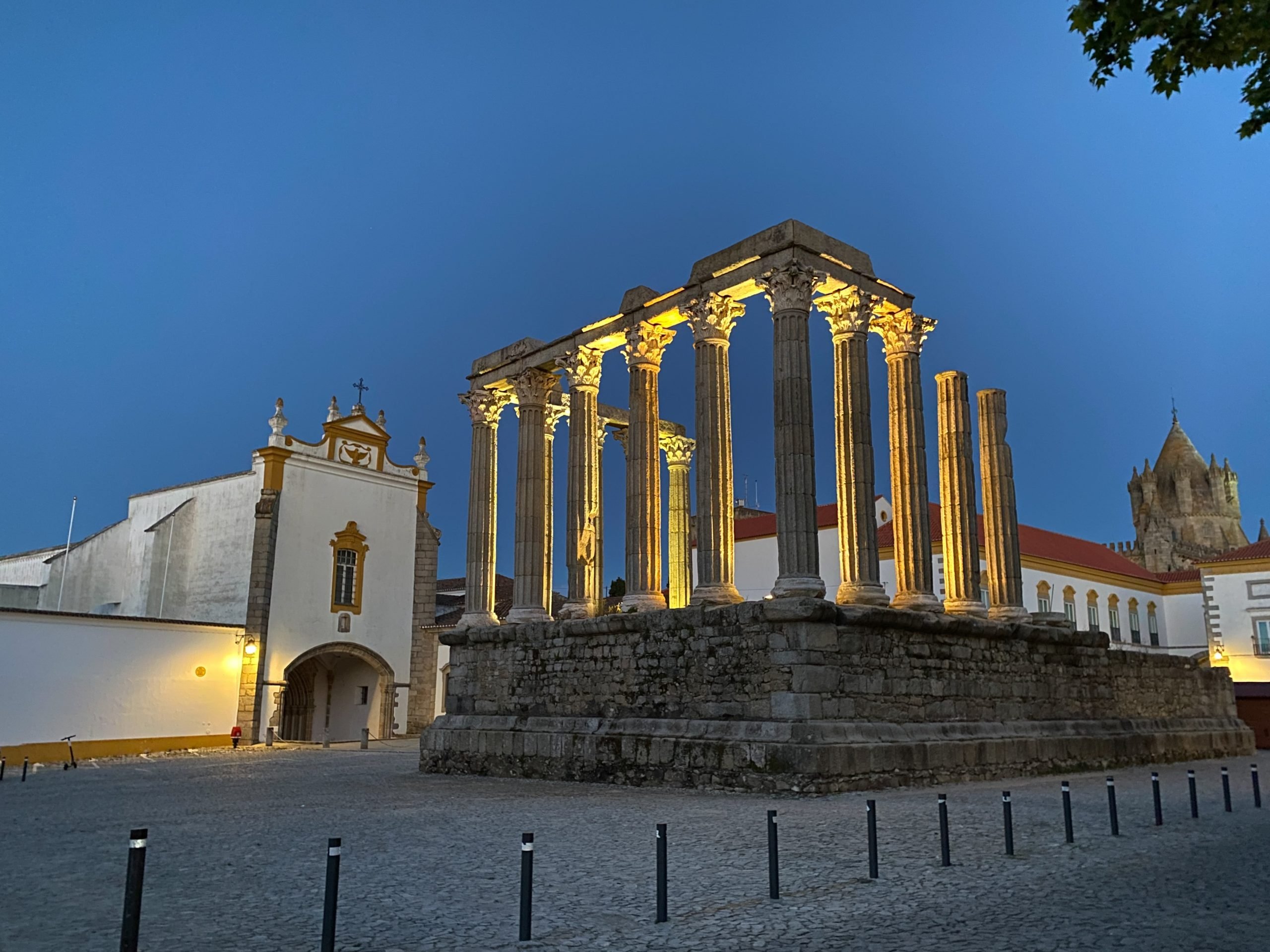
Where to go?
Mora (Km 468): this charming place, which is home to national monuments, attracts because of both its natural and rural beauty. Its landscape features vineyards and olive groves, and the town is known for its oil production and wines. Being close to the Gameiro Dam, it provides plenty of waterside spots and opportunities to participate in water activities. Moreover, travelers can explore local wineries and olive oil estates, and partake in tastings. Home to one of the most suggestive megalithic structures in national territory.
Montemor-o-Novo (Km 494): this County is a place of history and culture. The past can be grasped anywhere you look. In the town, a stunning medieval castle presides over the landscape and offers mesmerizing panoramic views of the surrounding region. Its historic center has small white houses, cobbled streets, and many small local handicraft stores. Outside or inside the castle, this place is perfect to understand the soul of Alentejo feeling both the past, and the present.
Alcáçovas (Km 550): this is a peculiarly historic town. It was the place where, in 1479, Portugal and Spain were to sign the first treaty set to establish a division of the world between two powers (like the Tordesillas Treaty, signed between the two powers and the Catholic Church 15 years later). Today, it is known for its culture, for its renaissance style architecture, and for its beautiful artisan products. Alcáçovas offers a glimpse into the country’s artistic and cultural heritage.
What to see?
- SCMM’s Museum Nucleus: inaugurated in 2012, this museum hosts an historical archive, an exhibition of sacred art, an exhibition of its loot of benefactors, photography displays, and other events. (Mora);
- Convent of São Domingos’ Museum Nucleus: home to the museum of archeology, pottery rooms, sacred art, ethnography, and bullfighting. (Montemor-o-Novo);
- Escoural Caves: these caves are a prehistoric rock-art site and funerary burial site, with Neolithic paintings and engravings. Located in a subterranean structure of a cliff face, these caves were discovered in 1963. (Escoural, halfway from Montemor to Alcáçovas, through N2);
- Church of Nossa Senhora da Conceição: this beautiful church, founded in 1622, is attached to the gardens of the royal palace. It still presents a distinct decoration composed of shells, limestones, and painted pottery. (Alcáçovas).
- Megalithic Circuit: travelers can look up the several megalithic structures and create a tailored circuit to visit. There are sites spread throughout the district.
Where to stay?
- Monte da Fraga (Mora);
- Hotel Solar dos Lilases (Mora);
- Azenhas da Seda (Mora);
- Casas de Romaria em Brotas (next to Mora, a bit further south through N2);
- Hotel da Ameira (Montemor-o-Novo);
- L’And Vineyards (Montemor-o-Novo).
Where to eat?
- Restaurante Afonso: a family owned restaurant opened more than 60 years ago. It is the perfect place for savoring Alentejo’s typical gastronomy. (Mora);
- Quinta do Espanhol (Mora);
- O António (Mora);
- A Palmeira: despite the simplicity of the decoration, this place is known for its famous delicacies. Some travel more than a hundred kilometers just for that reason. Quality products, wine selection, and desserts. (Mora);
- A6: located next to the municipal pool, this typical restaurant is known for its quality cuisine, and excellent service. (Montemor-o-Novo);
- Pátio dos Petiscos: typical regional dishes made in an innovative way. Fusion cuisine. Very good products and wine selection. (Montemor-o-Novo);
- Manuel Azinheirinha: this old family restaurant is a true hidden gem. It is very small and it is always full (booking is advised). The food is out of this world. (Between Montemor and Alcáçovas);
- Sabores da Vila (Alcáçovas).
Where to drink?
- Fernando Manuel Roma Pereira Toscano – Quinta da Horta de Chaves (Mora);
- Quinta Seca (Mora);
- Magnum – Carlos Lucas, Vinhos Lda. (Mora);
- Quinta da Plansel (Montemor-o-Novo);
- Herdade do Menir (Montemor-o-Novo);
- L’And Vineyards (Montemor-o-Novo).
District 9 – Setúbal – Kilometers 558 to 576
The next of the 11 districts is the District of Setúbal. Just like the Leiria District, Setúbal is renowned for its blend of coastal beauty and rural serenity. The 18 kilometers of N2 that pass through this district offer a unique opportunity to admire the transition from the cork oak landscape to the pine trees and olive groves.
Even though N2 crosses a very small portion of the right side of the district, which is part of Portugal’s true countryside, it is still within decent reach of the district’s coastal wonders. Notwithstanding, our path along National Road 2 retains a distinct charm with the rustic villages and the vineyards that produce some of the region’s famous wines. Travelers will definitely be able to experience another facet of Portugal’s authentic and serene countryside.
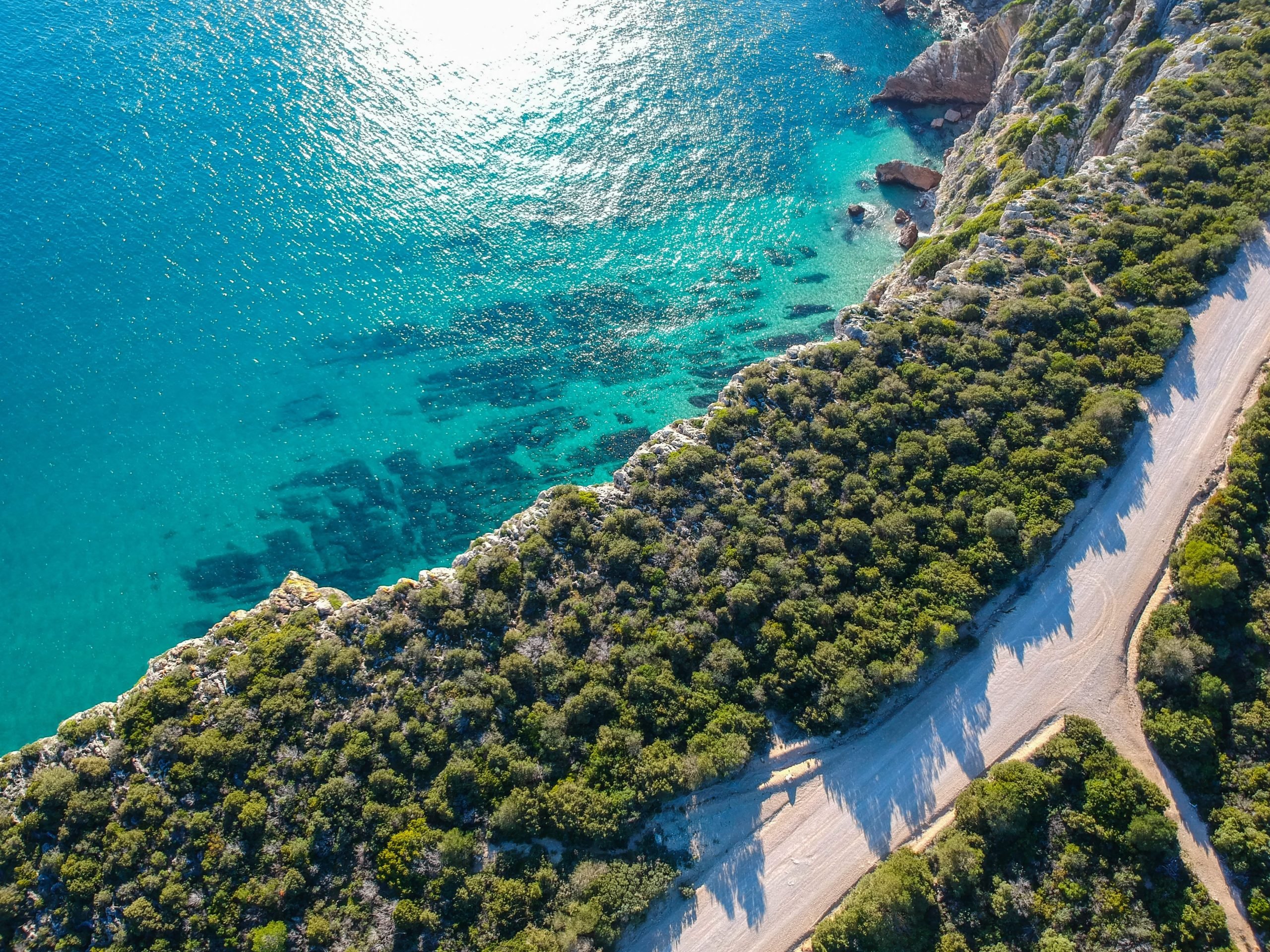
Alexandre Contador (Unsplash)
Where to go?
Torrão (Km 565): this town offers travelers an unspoiled taste of rural Portugal. Established right in the middle of the Alentejo region, Torrão is an ideal place to experience local cultural traditions and appreciate the simplicity of our countryside life. Moreover, it can serve as a gateway for exploring the mesmerizing beauty of Arrábida Natural Park, a bit far west, by the water.
What to see?
- Igreja Matriz do Torrão (Mother Church): this beautiful church was built in the beginning of the 16th century, on top of another temple built centuries before. Classified as property of public interest. (Torrão);
- Chapel of Arranas: this monument of public interest is partially ruined, however, it is worth a visit. It was built during the 7th century, the Visigothic period, and is thought to be on top of an old roman temple of the cult of Jupiter. (Torrão);
- Chapel of Nossa Senhora do Bom Sucesso: this is a construction from the 16th century, ordained by King D. Manuel I. (Torrão).
Where to stay?
- Vale do Gaio Hotel – S. Salvador (Torrão).
Where to eat?
- Restaurante O Tordo (Torrão);
- Restaurante O Chaparro (Torrão);
- Restaurante Excelentíssimo: a nice venue that serves quality traditional food. True typical food from Alentejo. The menu changes according to the time of the year. Booking is advised. (Torrão);
- Restaurante O Afluente do Sado (Torrão);
- Restaurante O Besugo: typical gastronomy from Alentejo, based on simplicity and quality products. Advised to call beforehand and ask about the dishes and products of the day. (Torrão).
Where to drink?
- Herdade das Soberanas (Torrão);
- Herdade do Portocarro (Torrão).
District 10 – Beja – Kilometers 577 to 682
Beja, the final district of Alentejo along National Road 2, is a destination that encapsulates the timeless charm and tranquility of the Alentejo region. With its expansive golden plain fields, rolling vineyards, and beautiful towns, this district offers another perfect escape from the hustle and bustle of city life.
The Beja District is steeped in history, from the Roman-times ruins to the stunning medieval constructions, it is a place for contemplation. Within this district, travelers can savor traditional cuisine from this part of Alentejo, explore historic sites, and properly embrace the unhurried and unworried way of living. The mix of rural beauty, historical richness, and traditional culture make it a top spot for those seeking the authentic, and laid-back, Portuguese experience.
Moreover, the district is home to the biggest dam in the country (Alqueva), and other large artificial lakes, making it ideal for water enthusiasts as well. Most of the path along N2 is made of straight lines, however, its final stretch is known as the road of the 365 curves – perfect for those who enjoy driving.
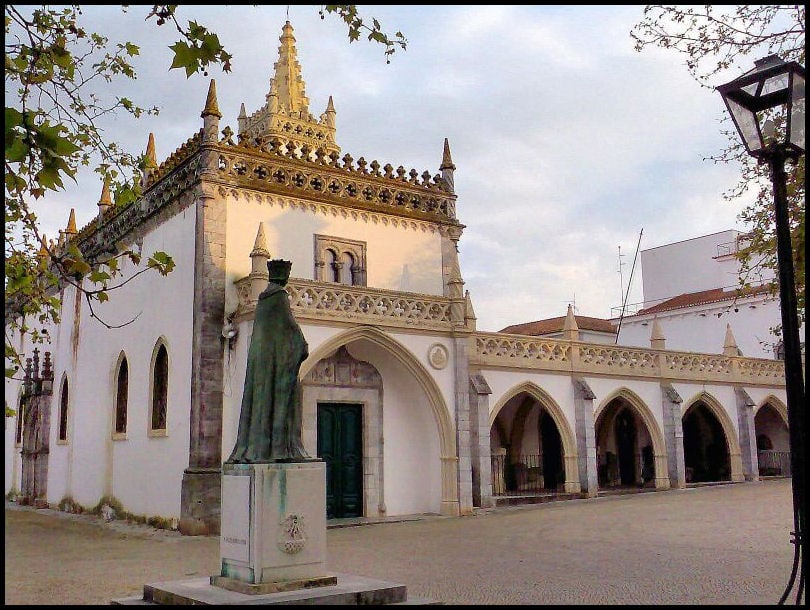
Where to go?
Aljustrel (Km 606): this is a place with a strong mining heritage. It is its standout feature. Mina de São Domingos, once a bustling mining location, now offers an intriguing look into the past with its abandoned mines, industrial structures, and weird yet captivating atmosphere. The town’s religious heritage is also noteworthy, with several churches and chapels throughout its streets. The surrounding countryside, with its hills and olive groves, provides an ideal location for exploration and relaxation.
Castro Verde (Km 631): Castro Verde is known for its natural beauty, and is a very good place for birdwatching. The Special Protection Area is a paradise for bird lovers, hosting a variety of species in their natural habitat. The town itself holds a distinct charm, with its traditional white-washed buildings and its meandering streets that create a specific atmosphere. Travelers can also taste its local culture and cuisine.
Almodôvar (Km 651): this place’s appeal lies in its rich cultural traditions and local craftsmanship. Travelers can immerse themselves in the town’s handicrafts, like pottery and cork products, whilst appreciating the authenticity of its rural way of life. The historic center invites leisurely exploration, and the surrounding countryside provides beautiful landscapes and a tranquil atmosphere.
What to see?
- Municipal Archeology Museum of Aljustrel: this museum, located near the archeological site of the Aljustrel Castle, offers a glimpse into the town’s past. The collections of artifacts from the different civilizations that settled there, from ancient to more recent times, allow us to better grasp the history. (Aljustrel);
- Castle of Aljustrel: the ruins of the castle reveal an occupation that dates back to prehistory and, more specifically, to the copper age, some 7 thousand years ago. It is believed to have expanded during the Roman and Muslim periods. (Aljustrel);
- Aljustrel Mining Route: this 12km long trail connects all points of interest. A curious experience that is worth having. (Aljustrel);
- Dona Maria House: this exceptional building marked the arrival of a new material, reinforced cement. Today, it is a beautiful museum house. (Castro Verde);
- Basílica de Nossa Senhora da Conceição: built on top of the old mother church, this architectural piece tells the history if an important battle (batalha de Ourique), and is an exemplar of the baroque style. (Castro Verde);
- Museum of Writing: this remarkable museum tells a history of communication. This lively and ever-evolving space showcases an evolution of spelling and written knowledge dating back to 2 thousand and 5 hundred years ago. (Almodôvar);
- Ethnographic and Archeological Museum Manuel Vicente Guerreiro: this museum allows us to better understand the region’s past. It tells a history that started in the 4th century BC. and stretches until the middle of the last century. (Almodôvar).
Where to stay?
- Hotel Villa Aljustrel (Aljustrel);
- Monte dos Poços Agroturismo (Aljustrel);
- Hotel Vila Verde (Castro Verde);
- Monte Coito (Almodôvar)
Where to eat?
- Fio de Azeite: the restaurant of Hotel Villa Aljustrel is one of the best gastronomic references in town. Known for its high-quality traditional food. (Aljustrel);
- A Cavalariça: known for the traditional regional food. Some say that the quality of the service does not reflect the quality of the food. (Castro Verde);
- Castro: known for its meat dishes and cheese selection. (Castro Verde);
- Restaurante Cornélia (Almodôvar);
- Tasquinha do Medronho: typical snacks from Alentejo. Known for its grill. (Almodôvar).
District 11 – Faro – Kilometers 683 to 738.5
Here we enter the final stretch of our journey. Km 683 marks the beginning of another region, which is called Algarve. This is a very well known destination, right in the south tip of Portugal. This final part of N2’s path is the least populated of all the 11 districts. In fact, this was the last part of the road to be built, connecting the lands of the center-north to Algarve.
The last 55.5 kilometers of this unique road provide a transition from the rural and less populated areas of Portugal, through the mountain, to the urban vibrancy of Faro (where it ends), one of the busiest cities crossed by N2. While passing through the serene countryside, before reaching Faro, travelers can enjoy Algarve’s hidden natural beauty.
Interestingly, like in the rest of the country, this is what most people do not, but should, know. The mix of Algarve’s way of living, its rural and urban charm, and stunning natural landscapes make it another top destination, and the perfect end for our journey.
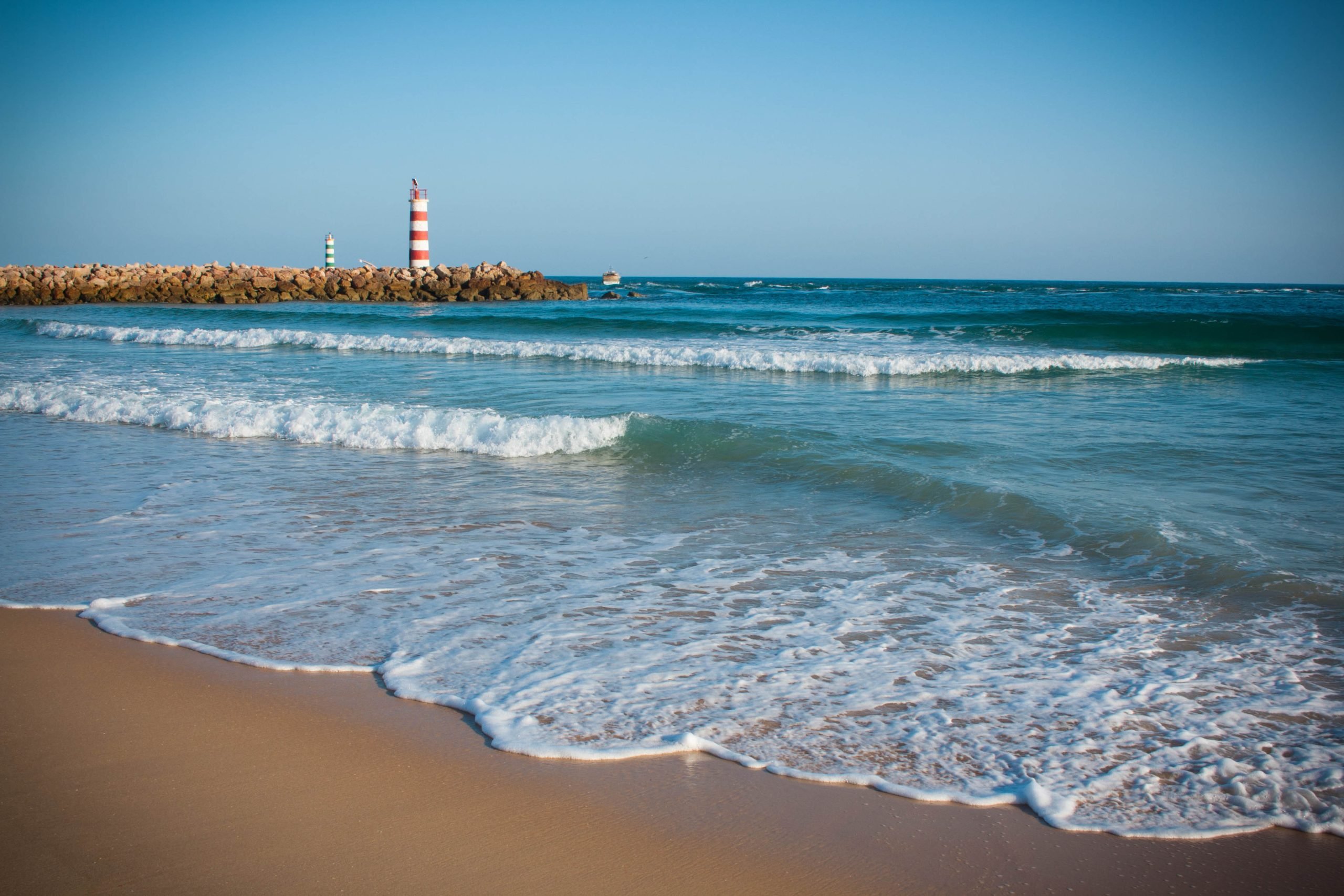
Where to go?
São Brás de Alportel (Km 721): this town used to be an important hotspot for the cork trade in the 19th century. Given more recent road works, properly following N2 through this town is an impossible task because of the traffic signs. Notwithstanding, it is a hidden cultural gem in the Algarve. It is known for its traditional architecture full of Moorish and Mediterranean influence, its historic streets, and its atmosphere, providing a perfect opportunity to discover the authentic rural culture of this region.
Faro (Km 738.5): this is where N2 ends. Faro, Algarve’s main city, is the ultimate destination and a striking contrast to the rural areas that precede it. The city boasts a vibrant atmosphere, historical sites, and an amazing urban lifestyle. It is known for its cultural sites, such as Old Town, the Cathedral, and the many museums. Furthermore, its coastal location provides easy access to beautiful beaches, and to the islands right in front of it.
What to see?
- Bridge that connects the District of Beja and the District of Faro: this beautiful bridge was built from 1890 to 1913 (Right over the Vascão river);
- The landscape: along these kilometers of N2 there are not many monuments. The area is very poor, and the landscape is what truly counts. To get mesmerizing panoramic views, visit the Caldeirão viewpoint;
- Church of Barranco Velho: the value of the visit is not on the architecture, nor the antiquity, but on the surrounding landscape. It is a marvelous viewpoint;
- Museum of Faro;
- Ria Islands: these islands are located in front of Faro, between the coast and the Atlantic Ocean. They are definitely worth visiting. Some have houses, some do not. If you’re looking for a unique experience, check them out. (Faro);
Where to stay?
- Rocha da Gralheira Hotel & Restaurant (São Brás de Alportel);
- Pousada do Palácio de Estói (between São Brás and Faro).
Where to eat?
- Casa dos Presuntos: this restaurant is more than 100 years old. Known for its high quality traditional food. (Km 706, before São Brás de Alportel);
- A Tia Bia: known for its high quality food. Culinary from Alentejo, and the mountains of Algarve. Very good products. (Km 708,5, before São Brás de Alportel);
- Restaurante Ysconderijo: inviting atmosphere, good food, nice and efficient service, and quality products. A recommended place. (São Brás de Alportel);
- Bocaxeia: this is one of the best restaurants in Faro. Highly recommended. Booking is advised. (N2, Faro).
National Road 2, stretching from the northern border with Spain, to the southern coast by the Atlantic Ocean, provides an authentic display of Portugal’s rich and diverse architectural, cultural, culinary, and natural landscapes. While the descriptions of the regions and towns crossed by N2 provided here may appear somewhat similar, each place holds a unique charm that reveals the multifaceted authenticity of this beautiful country.
From the rustic allure of the northern interior to the historic wonders of the central regions, and the coastal beauty of the south, National Road 2 is an immersive journey through the heart and soul of Portugal. Along this iconic route, which should be done slowly and carefully so nothing misses the eye, travelers are treated to regional culinary delights, lush natural landscapes, and a genuine look into the true Portuguese way of life.
The atmosphere evolves from one district to the next, but does not really change at all. The Portuguese essence is present in all of them. In fact, that same essence is made up of all of them. Portugal’s complex mosaic comprises the distinctiveness of its regions, cities, and towns, and National Road 2 serves as a remarkable path to uncover the country’s true identity, promising an unforgettable adventure through this incredible country.



The restaurants listed for District 3 as the same ones listed for District 4.
Dear Marietta, Thank you so much for pointing this out. We have received the updates from the author and made the changes.